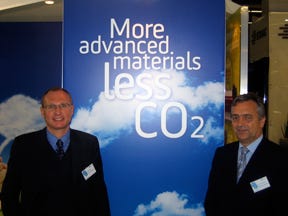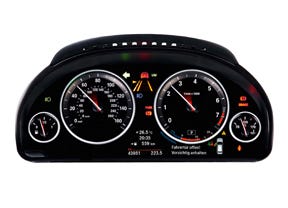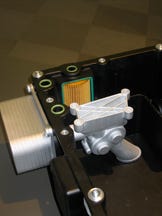Held in Frankfurt, Germany in mid-September, the IAA (Internationale Automobil-Ausstellung) remains the world’s largest car show, but this year’s version showed the signs of the prevailing market conditions.
November 30, 2009
Held in Frankfurt, Germany in mid-September, the IAA (Internationale Automobil-Ausstellung) remains the world’s largest car show, but this year’s version showed the signs of the prevailing market conditions.
Almost 30% fewer exhibitors booked space, with some leading brands—Honda, Mitsubishi, and Nissan—passing on the event. Compared to the previous show in 2007, this year’s also was tellingly absent of many top Tier One and Two suppliers. The ones who did exhibit were not shy to say that their presence proved their support of the industry, naturally, and despite the sales slowdown, it remains a mammoth market. Many at the event commented that in fact sales in Asia and India hit a minor bump in late 2008 but just kept going. In Europe and North America, car demand may turn worse in 2010 as the artificial impetus of various “cash for clunkers” programs runs its course.
|
In 2007 the mega-trend at the IAA was reduced carbon dioxide emissions, at the time very much under the microscope as then-pending European Union regulations (since watered down) were expected to force drastically improved gas mileage requirements on carmakers. With green carpeting, wallpaper, and mood lighting the prevailing shade at the 2009 IAA, there was no overseeing the “environmentally responsible” marketing movement at many exhibitors’ booths, punctuated by the display of more alternative-energy vehicles than likely are actually on the road in Frankfurt.
For plastics processors, alternative energy for car propulsion could eventually prove a bonanza, opined experts at two plastics suppliers, Rhodia and Lanxess, competitors in the polyamide market. At Rhodia (Lyon, France), Jean-Claud Steinmetz, VP automotive/transportation for nylon (PA6 and PA66), predicted that hybrid gas/electric engines would be good for his company and its processing customers, as the smaller gas engines in these often run at higher temperatures and with a turbocharger, prompting the need for high-heat-stable plastics.
Jürgen Selig, application development manager, transportation, for semicrystalline materials at Lanxess’s R&D facility in Dormagen, Germany, sees opportunity on the battery-powered side of the engine as well. The company is working on a molded hybrid plastic/metal development for a circa 70-kg battery, he said, with the plastics key to parts integration. He also expects the surge of interest in electric cars to develop into proving grounds for flame-retardant thermoplastics. “Not much can go wrong with a 12V battery, but with the powerful ones being developed, flame retardancy will be critical,” he noted.
Lanxess continues to see application potential for hybrid plastic/metal structures, a field it helped develop. In 2008, said Selig, 78 different cars were fitted with hybrid front ends molded with the supplier’s Durethan polyamide. Newly designed versions using PA with 60% glass-fiber reinforcement, double that on most now commercial, will reduce the front end’s weight by almost 40%, he said. He says such hybrid moldings also are finding their way into other parts of the car, notably door panels and dashboards. “In about 2011 there will be commercial applications of both of these,” he said.
In a car’s fuel tank and fuel transport system, Steinmetz sees a potential growth area for PA, especially for small city cars, hybrid vehicles, or those running ethanol or other bio-fuels. Polyamide from Rhodia is already being blowmolded for single-layer motorcycle fuel tanks, and he said ongoing tests “look promising” for PA’s use in monolayer tanks for cars running bio-fuel. Smaller cars could be made much lighter if fuel tanks carried only 40 liters (about 10.6 gal) of gas, he said, and at that size a monolayer blowmolding may make more economic sense and be just as efficient in combating emissions as the multilayer PE/EVOH tanks currently used.
Oil filter modules learning new tricks
Tier One supplier Mann+Hummel (Ludwigsburg, Germany) commercially introduced the first plastic modules some five years ago, and since then these PA moldings have made significant inroads into what was once exclusively a stamped aluminum application. The first of what the tier supplier is calling its second generation of oil filter modules is already being installed commercially on BMW’s new six-cylinder inline diesel engines, molded with PA66 with 35% glass-fiber reinforcement.
A prototype of this second generation of thermoplastic oil filter modules was displayed at M+H’s stand at the IAA and included an integrated oil filter housing and filter, an oil pump integrated into the molding, and a newly developed filter with an anti-drain membrane that can reduce the anti-drain pressure by a factor of 10, thus increasing the efficiency of the oil pump, according to Pius Trautmann, director of fluid filter development.
Rhodia’s Steinmetz said the first oil pans using his company’s PA66 are entering commercial use on Mercedes’ new 2.2-liter diesel sedans. “Every OEM is looking at plastic oil pans,” he noted. One of the few tier suppliers exhibiting, ElringKlinger (Dettingen, Germany), displayed some of the PA oil pans it has developed next to the firm’s more established aluminum ones.
The most formidable tier supplier stand belonged to Johnson Controls, where officials also shared that the company expects to at least break even for the year. In what the Tier One supplier says is a world novelty, it is negatively thermoforming 3D instrument cluster panels for BMW using a black sheet it developed that allows warning lights and other displays to brightly shine through it, with no sign of distortion and no need for a secondary anti-reflective coating. The parts also show no sign of polarization at their sharp edges.
Patrick Nebout, director of product management and strategic planning for Johnson Controls’ Global Driver Information unit, told MPW that by placing the film face down in the tool, the texture of the tool gives the film’s surface an embossed structure that eliminates the need to add an anti-reflective coating to the surface of the cluster. The result is an instrument cluster with much sharper resolution.
He also said the company has optimized its thermoforming so as to reduce the reflection/interference known as Newton’s rings at the sharp thermoformed edges between the flat printed analog speedometer and tachometer, and the surrounding digital information display.
The company showed off a broad range of instrument clusters, most of them drawing attention to the individual “looks” it can achieve on injection molded decorative rings that could be added to, for example, the speedometer to give it a carbon-fiber-printed surface appearance or a chrome appearance. “This lets our customers differentiate their brands without a big investment,” explained Nebout. Also on display were some prototypes revealing how the instrument cluster of the future might appear, with a TFT (thin film transistor) display integrated into the speedometer and tachometer so that a driver would see not only speed or RPMs but also entertainment system information, navigational advice, and more.
Johnson Controls has been actively processing natural-fiber-reinforced plastics for more than 50 years, but took this experience to the next level with a concept car it displayed at the IAA on which almost all of the visible interior surfaces were processed from these materials. The look was actually quite attractive, a clear step down the value chain from real wood surfaces, but nonetheless as attractive or more so than standard polypropylene and ABS interior components. The company’s PP Thin Film, a cast multilayer structure, is used to protect the natural-fiber-reinforced surfaces from scratching and from fading/discloration caused by the sun’s rays.
It seems likely, based on these and other discussions, that plastics processors still have many opportunities in the automotive market, and that car OEMs’ own financial travails could create opportunities for those processors with the financial and technical wherewithal to be chosen for these forward-looking projects. —Matt Defosse
About the Author(s)
You May Also Like





